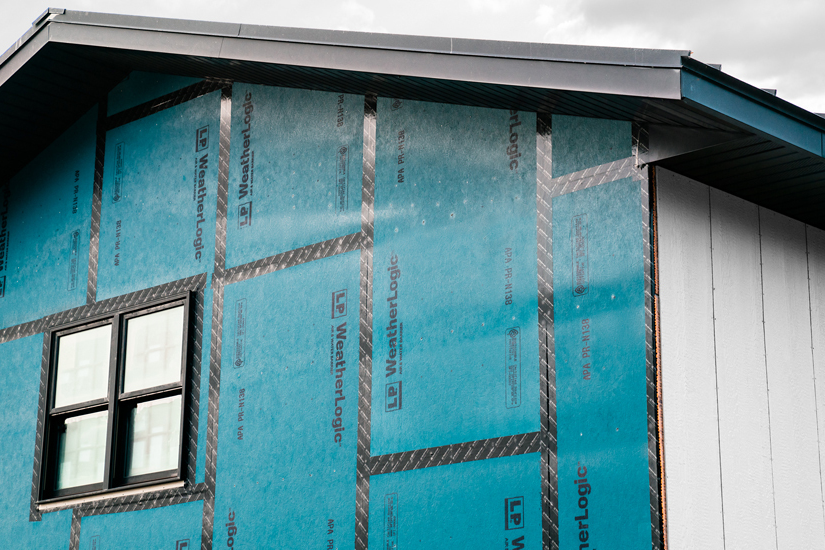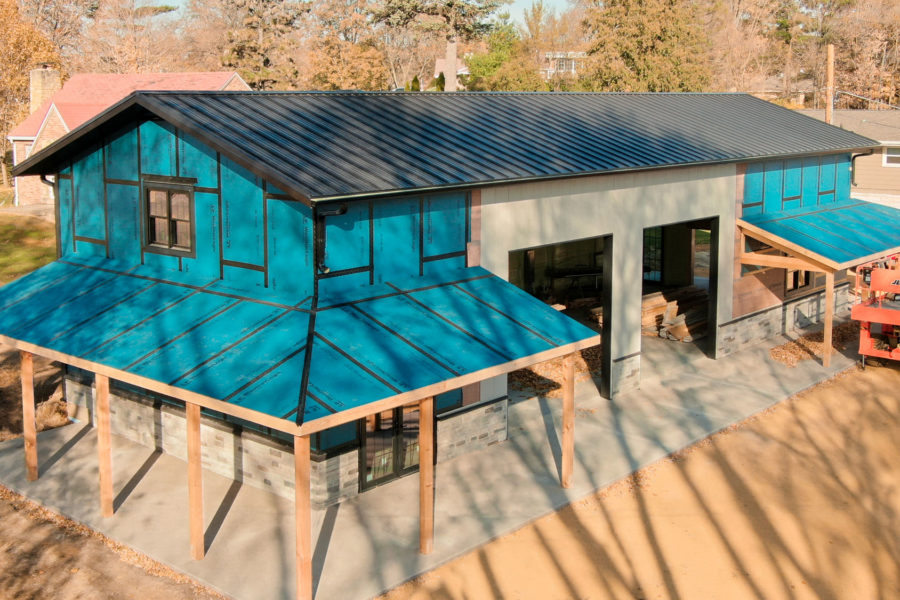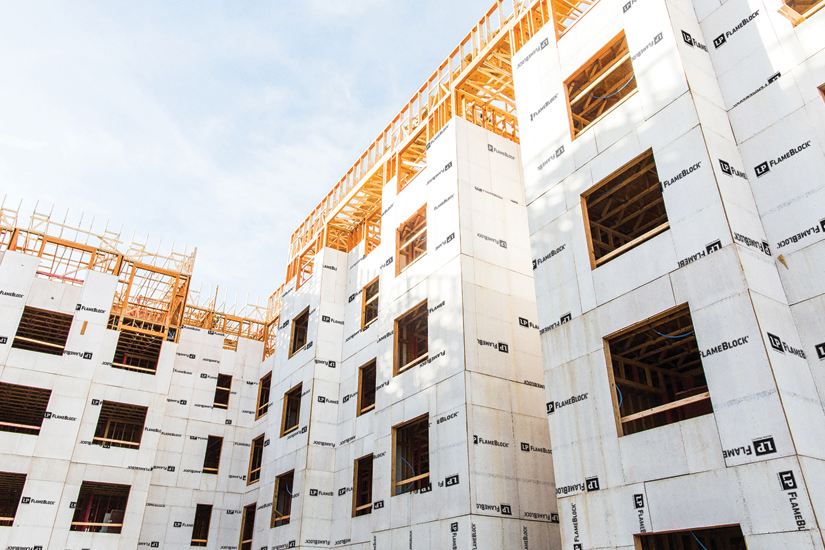For many homeowners, now is the time to consider energy efficiency in their homes, whether they are remodeling or buying a newly constructed home. In fact, according to a study conducted by the National Association of Home Builders (NAHB), 90% of home buyers would rather purchase a home with energy-efficient features that help permanently lower their energy bills as compared to a home with lower upfront costs.
Additionally, homeowners desire to ensure their homes are resilient, not only to weather but also to the ebb and flow of energy costs. They want to have products and measures in place that help them feel confident that their homes will always be working behind the scenes as efficiently as possible. As the building industry becomes more aware of the need to protect our planet and use energy more wisely, you can expect more questions about energy efficiency.
You can improve the energy efficiency of your builds by installing a radiant barrier. The LP TechShield Radiant Barrier sheathing, for instance, has been installed in over 2 million homes across the US and proven to be the best radiant barrier, giving you a way to offer clients increased peace of mind when it comes to energy costs and efficiency.
How Does Heat Transfer?
First let’s understand how heat transfers and why a radiant barrier can be a necessary addition to a build. Heat moves by a combination of conduction, convection, and radiation from hot to cold areas. Radiant barrier technology tackles radiation, reducing the effects of the sun’s energy as it transfers to the attic of a home.
Types of Radiant Barriers

Photo courtesy of LP Structural Solutions
According to the US Department of Energy, radiant barriers usually involve a highly reflective material such as aluminum foil. This can be attached to many different substrates, from kraft paper and oriented strand board (OSB) to cardboard and plastic films. They can be combined with insulation systems as well.
The LP TechShield Radiant Barrier, for example, boasts impressive energy efficiency, helping to block radiant heat in roof panels from emitting into a home’s attic. This can reduce attic temperatures by up to 30°F. Its patented VaporVents™ Technology also helps trapped moisture to escape from the panels before and after installation. Backed by a 20-year transferable limited warranty, LP TechShield panels block up to 97% of radiant heat, which can translate to lower energy bills. Here’s how it works.
How It’s Made
LP TechShield panels begin with PS2-certified OSB substrate, built for strength and durability with resins, waxes, and sealed edges. Then, to create a radiant barrier for roofs, a thin, durable layer of aluminum is bonded to the panel. Next, with LP’s post-lamination incising process, VaporVents technology is added.
Installation Made Simple
LP Structural Solutions makes ease of installation a top priority with all its products. That’s why, even with added radiant barrier benefits, LP TechShield panels install just like regular sheathing. You won’t need to add any labor or factor in additional time for installation. It installs with standard woodworking tools, as well—just make sure the foil side is installed facing downward and the skid-resistant side facing up.
Contributions to Green Building
LP TechShield Radiant Barrier is recognized widely as a way that you can provide your clients with energy-efficient materials. For example, it may help you qualify for certain Green Building credits and contribute to other sustainable building standards, such as LEED and WELL Building certifications.
Importantly LP TechShield panels can also help you achieve a lower Home Energy Rating System (HERS) Index score. This industry standard measures a home’s energy efficiency. The lower a home’s HERS score, the higher its energy efficiency will be.
According to the US Department of Energy, a typical existing resale home scores about 130 on the HERS index, which adds up to utility costs of around $200,000 over a 30-year mortgage. However, a HERS score of 100 would lead to a 30% reduction in costs—savings of almost $60,000 over the same period of time. A score of 65 cuts the costs nearly in half.
As you can see, every step you can take toward energy efficiency translates to fewer HERS points—and then to fewer dollars spent by the homeowner. That’s why it’s more important than ever to evaluate each product you choose and invest in those that will offer your homeowners the best chance at the efficiency—and savings—they want.
Durability and Resiliency
Backed by LP’s consistent technology and innovative approach to OSB sheathing, LP TechShield roof sheathing can be trusted for your build. Not only is it a primary factor in each build’s resiliency, it offers the durability you expect from LP Structural Solutions. Available in several performance categories and on APA Exposure 1 rated OSB, LP TechShield panels offer the stability you need in a roof sheathing material.
Tackling Hot Climates
Although many climates can benefit from the extra reassurance a radiant barrier brings, if you’re building in hot climates that deal with heat for large portions of the year, radiant barriers become even more crucial. Radiant barriers can help make a noticeable difference in homes that experience high heat, taking pressure off a home’s HVAC system for cooling.
A Portfolio Approach to Energy Efficiency

Photo courtesy of LP Structural Solutions
You’ve got one product to take care of radiant heat, but what about the rest of the concerns for your build? You may want to ensure your structures are protected from flame spread if you’re building, for example, in a Wildland Urban Interface (WUI) zone, or a build may need extra moisture management because it’s located within a humid climate.
The good news: LP TechShield Radiant Barrier doesn’t stand alone—it’s part of a portfolio of products by LP Structural Solutions that are proven to Defend Your Build. Designed to work together with the rest of the LP Building Solutions products, it complements other efficiency, resiliency and defensive efforts. You can customize the products you use from the portfolio according to your region’s needs, as well, from fire-rated sheathing and premium sub-flooring to air and water barriers. LP makes it easy for builders like you to offer your clients the exact materials they’ll need for a durable, resilient home that lasts.
Make Your Builds More Energy-Efficient With a Radiant Barrier
Odds are that more of your clients will begin asking about energy efficient solutions for their homes. Once a home is built, homeowners can make small adjustments to their living styles to live more sustainably. However, installing products that help reduce energy costs at the level of the framework of the home is a long-term way of ensuring their homes work hard to combat high energy use. These initial steps go a long way in giving your clients the peace of mind they need.




